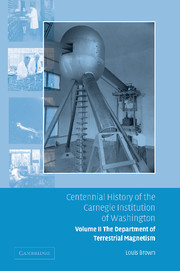Book contents
- Frontmatter
- Contents
- Foreword by Richard A. Meserve
- Preface
- 1 Establishment
- 2 Cruises and war
- 3 Expeditions
- 4 Measurements: magnetic and electric
- 5 The Fleming transition
- 6 The last cruise
- 7 The magnetic observatories and final land observations
- 8 The ionosphere
- 9 Collaboration and evaluation
- 10 The Tesla coil
- 11 The Van de Graaff accelerator
- 12 The nuclear force
- 13 Fission
- 14 Cosmic rays
- 15 The proximity fuze and the war effort
- 16 The Tuve transition
- 17 Postwar nuclear physics
- 18 The cyclotron
- 19 Biophysics
- 20 Explosion seismology
- 21 Isotope geology
- 22 Radio astronomy
- 23 Image tubes
- 24 Computers
- 25 Earthquake seismology
- 26 Strainmeters
- 27 The Bolton and Wetherill years
- 28 Astronomy
- 29 The solar system
- 30 Geochemistry
- 31 Island-arc volcanoes
- 32 Seismology revisited
- 33 Geochemistry and cosmochemistry
- 34 The Solomon transition
- 35 The support staff
- 36 Epilogue
- Notes
- Index
29 - The solar system
Published online by Cambridge University Press: 06 January 2010
- Frontmatter
- Contents
- Foreword by Richard A. Meserve
- Preface
- 1 Establishment
- 2 Cruises and war
- 3 Expeditions
- 4 Measurements: magnetic and electric
- 5 The Fleming transition
- 6 The last cruise
- 7 The magnetic observatories and final land observations
- 8 The ionosphere
- 9 Collaboration and evaluation
- 10 The Tesla coil
- 11 The Van de Graaff accelerator
- 12 The nuclear force
- 13 Fission
- 14 Cosmic rays
- 15 The proximity fuze and the war effort
- 16 The Tuve transition
- 17 Postwar nuclear physics
- 18 The cyclotron
- 19 Biophysics
- 20 Explosion seismology
- 21 Isotope geology
- 22 Radio astronomy
- 23 Image tubes
- 24 Computers
- 25 Earthquake seismology
- 26 Strainmeters
- 27 The Bolton and Wetherill years
- 28 Astronomy
- 29 The solar system
- 30 Geochemistry
- 31 Island-arc volcanoes
- 32 Seismology revisited
- 33 Geochemistry and cosmochemistry
- 34 The Solomon transition
- 35 The support staff
- 36 Epilogue
- Notes
- Index
Summary
When George Wetherill became Director in 1975 he introduced to DTM the study of the solar system, a discipline lying between astronomy and geophysics that nicely linked the two. At UCLA he had developed an interest in the origin of the solar system, which soon centered on the theoretical underpinnings of its origin. Theory had recently received an important boost from the Russian physicist V. S. Safronov, whose work during the 1960s marked the most important advance since the conjectures, in 1795, of Pierre-Simon Laplace who had proposed that the solar system consolidated from a rotating cloud of gas out of which the Sun formed.
This subject had been investigated by Thomas C. Chamberlin supported by one of the first grants awarded by the Institution. He tried to evaluate all observational evidence together with explanations proposed by various investigators of the nineteenth century, but these efforts were severely hampered by essentials that were not known and much that was known but wrong. He thought condensation directly from a gaseous Laplacian nebula dubious, as he saw it as unable to provide the thermal energy needed to melt rocks, and proposed that meteoritic material formed planetesimals that were subsequently fused into planetary nuclei through the kinetic energy of their impacts, a point of view similar in some respects to the later Safronov–Wetherill approach.
- Type
- Chapter
- Information
- Centennial History of the Carnegie Institution of Washington , pp. 221 - 226Publisher: Cambridge University PressPrint publication year: 2005



